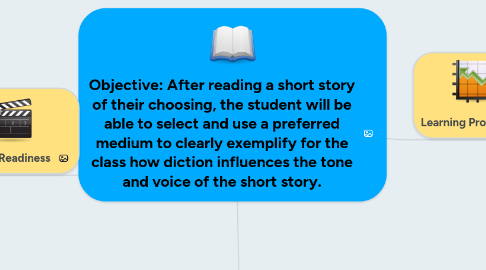
1. Levels of Readiness
1.1. Student A: English Language Learner
1.1.1. If this student is more comfortable doing so, allow her to read a short story in her native language. She will then have to figure out how to explain in English to the class how the diction is working in the story to create voice and tone; however, this in itself could be an excellent activity that can teach her to blend her languages/cultures and also allow her to be "the expert" in front of the rest of her classmates and possibly gain some confidence. In addition, also make sure she knows that she can use a presentation medium that doesn't require her to present live: for example, she may be more comfortable creating a video so that she can practice and edit when she's not on the spot in front of the entire class.
1.1.2. Teachers may want to read these linked articles (click on the arrow) for additional ideas on how to support ELLs by allowing them to use their native language.
1.2. Student B: High-Achiever
1.2.1. Encourage this student to read two different short stories, whether by the same author, authors from the same time period, authors from different time periods, authors from different cultures, etc. Make sure she is choosing works that represent her interests and a presentation format that represents her learning profile. Then in her presentation she can work to compare and contrast the different diction, tone, and voice of the works and draw more extensive conclusions (about style, culture, gender, etc.).
2. Learning Profiles
2.1. Student A: Practical, Kinesthetic Learner
2.1.1. Suggest several non-fiction short stories for this student, such as a space flight story or something else that will help her in her studies or life. Encourage her to create a diagram to share her findings with her classmates: perhaps she could use a digital mindmapping tool or even create a 3D model using the school's 3D printer.
2.1.2. Helps: Post the websites for mindmeister, popplet, xmind, mind42, and lucidchart on the class server.
2.1.3. Share with students the following link (hover over the white arrow) on mindmapping:
2.2. Student B: Creative, Visual Learner
2.2.1. Suggest several creative short stories for this student, especially those that would also likely reflect his interests. Then give him some clear parameters but make sure he knows he can complete this assignment in any way that is rhetorically strong. Perhaps he will want to create a video, digitally draw a storyboard or comic, or even use paint, animation, or anything else he can think of to effectively present his findings.
2.2.2. Share this video (hover over the arrow) on visual thinkers with these students, or post websites on the class server for digital tools such as storyboardthat.com, vimeo, pixton, tondoo, etc.
3. Interests
3.1. Student A: Multicultural student who has grown up in England and China with a Thai mother and Israeli father
3.1.1. Mention to this student that she may choose short stories from any culture, or also suggest short stories to her that discuss the idea of multicultural heritage, etc. Also suggest that she may use other cultural elements (music, food, clothing, etc.) as further support for the arguments she is making.
3.1.2. Share with her this excellent research guide that contains a database of multicultural short stories (click on the arrow)
3.2. Student B: Baseball and Basketball Player
3.2.1. Encourage this student to find a story that is actually interesting. For example, is there a non-fiction story about or even written by any of his sports heroes? Also encourage him to use his knowledge of sports to interpret the tone and voice of the story.
